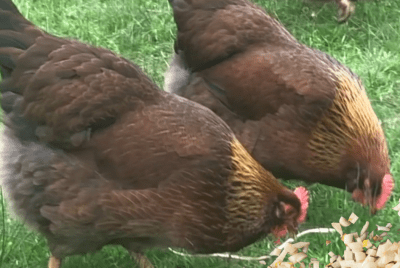7 Essentials for Backyard Chicken Coops
1.Introduction: 7 Essentials for Backyard Chicken Coops
You love your feathered friends, and providing them with a safe, comfortable home is a top priority. In this article ‘7 Essentials for Backyard Chicken Coops’ lets delve into the basic’s. With good basic’s you have a good grounding from where to launch your project. That’s why ensuring your chicken coop is well-equipped with proper ventilation, adequate space, nesting boxes, perches, predator protection, food and water stations, and lighting and insulation is crucial for their health and happiness. From preventing respiratory issues with good airflow to keeping predators at bay with secure fencing, each imperative plays a vital role in creating a joyful poultry experience for you and your birds.
Imagine your flock happily clucking, laying fresh eggs, and feeling cozy in their well-stocked coop. By focusing on these 7 imperatives, you’ll be setting the stage for a chicken paradise where your feathered friends can thrive. So, let’s investigate each imperative and learn how to create the perfect home for your beloved chickens.
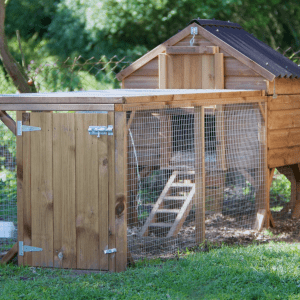
Key Takeaways:
- Adequate Space: Provide at least 3-4 square feet per chicken inside the coop and 10 square feet per chicken in the outdoor run to prevent stress and promote healthy behavior.
- Proper Ventilation: Ensure good airflow in the coop by having windows or vents that can be opened or adjusted to prevent respiratory issues in chickens.
- Nesting Boxes: Create cozy nesting boxes that are spacious enough for hens to lay eggs comfortably, with privacy and quiet surroundings.
- Perches: Install sturdy roosting bars higher than nesting boxes to mimic natural sleeping habits of birds and provide a safe spot for chickens.
- Predator Protection: Fortify the coop with hardware cloth, secure all entry points, and consider automatic coop doors to keep predators away and ensure the safety of your flock.
2. Selecting the Right Location
You’ve decided to build a chicken coop – now it’s time to pick the perfect spot. Your choice of location can significantly impact the health and happiness of your flock. Choosing the right location is crucial for providing a safe and comfortable environment for your feathered friends.
2.1. Considering Sunlight and Shade
Right from the start, consider the sunlight and shade in your chosen location. Chickens thrive in areas with a good balance of light and shade throughout the day. Aim to place your coop where it can receive ample sunlight for warmth and natural light cycles, while also having shaded areas for your chickens to cool off during hot days.
2.2. Ensuring Proper Drainage
Proper drainage is crucial to prevent your coop from becoming a soggy mess and risking health issues for your chickens. Choose a location with good natural drainage or consider implementing drainage solutions like sloping the ground away from the coop or installing a French drain. Poor drainage can lead to damp conditions, which can promote mold growth and attract pests, putting your flock at risk.
Location
Do not forget, the location of your chicken coop sets the foundation for a healthy and thriving flock. Take the time to assess sunlight exposure, shade availability, and drainage options to ensure your chickens have a comfortable and safe home.
3. Coop Design and Size
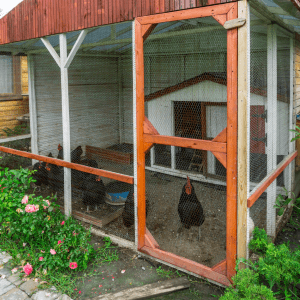
Now, let’s talk about the importance of a well-designed coop for your feathered friends. Your chicken coop should be carefully planned to provide a safe and comfortable home for your flock. In the matter of size, adequate space is important for the health and happiness of your chickens. Make sure to allow at least 3-4 square feet per chicken inside the coop and about 10 square feet per chicken in the outdoor run. More space is always better, as it can prevent stress, disease, and behavioral issues among your flock.
3.1. Space Requirements for Your Chickens
Your chickens need room to roam, peck, and play. A cramped coop can lead to stress, disease, and even feather pecking. Providing enough space allows your chickens to exhibit natural behaviors and leads to healthier, more productive birds. Aim to create an environment where your chickens have enough space to move around comfortably both inside the coop and in the outdoor run.
3.2. Features of a Well-Designed Coop
On top of space, a well-designed coop includes features that promote the health and well-being of your chickens. Think about proper ventilation to prevent respiratory issues, nesting boxes for egg-laying, sturdy perches for roosting, and predator protection measures. These features are important to creating a safe and comfortable living space for your flock.
Coop design also plays a crucial role in maintaining hygiene, reducing stress, and preventing behavioral issues among your chickens. Investing in a coop with adequate features can lead to a more joyful poultry experience and healthier, more productive birds. Consider incorporating these features into your coop design to ensure the well-being of your feathered friends.
4. Security Measures in Backyard Chicken Coops
4.1. Protecting Your Flock from Predators
All poultry enthusiasts know that keeping their feathered friends safe from predators is a top priority. An important security measure for your chicken coop is using hardware cloth instead of chicken wire to ensure maximum protection. Additionally, securing all entry points and investing in an automatic coop door that closes at dusk and opens at dawn can help safeguard your flock from nighttime threats like raccoons, foxes, and other predators.
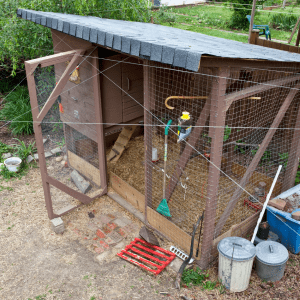
In this picture, the strings strung at different angles around the coop could serve several purposes:
a. Predator Deterrent:
The strings might be a simple and cost-effective method to deter aerial predators like hawks or owls, which could be startled by the unpredictability of the obstacles when flying.
b. Squirrel Barrier:
Considering our earlier discussion in another article, the strings could be intended to prevent squirrels and other small climbing pests from easily accessing the coop. Squirrels can be quite acrobatic, but a complex network of strings might confuse them or impede their direct path.
c. Support for Climbing Plants:
The strings might be designed to support climbing plants or vines, which could eventually provide additional cover and camouflage for the coop, adding an extra layer of protection and insulation. When building your coop be as creative as you can. Everything you do to protect your flock will reward you in longevity and bountiful egg laying by your hens,
d. Visual Aid:
They might be there to prevent chickens from attempting to fly out of the coop, as well as to provide a visual aid to help people avoid bumping into or tripping over lower parts of the structure.
Each string’s placement looks intentional, suggesting a multi-purpose strategy to both protect the chickens and potentially improve the aesthetics of the coop over time.
4.2. Making Your Coop Weather Resistant
Weathering the elements is crucial for maintaining a comfortable and safe environment for your chickens. Insulating your coop is key to protecting your flock from extreme temperatures. From providing extra insulation in winter to ensuring adequate shade and access to water in summer, your coop should be equipped to handle all weather conditions. Proper ventilation and a well-sealed coop are also important for keeping your chickens healthy and happy all year round.

5. Ventilation and Insulation in Backyard Chicken Coops
5.1. Balancing Airflow with Insulation
For a well-maintained chicken coop, it’s vital to strike a balance between ventilation and insulation. Proper ventilation keeps the coop free from dampness and ammonia build-up, which can harm your flock’s respiratory health. On the other hand, insulation is crucial for protecting your chickens from extreme temperatures, especially during colder months.
Consider using natural materials like straw or hay for insulation, along with ensuring windows or vents are adjustable for proper airflow.
5.2. Seasonal Adjustments for Temperature Control
One way to ensure your chickens stay comfortable year-round is to make seasonal adjustments for temperature control.
During the winter, add extra insulation and consider using heat lamps to keep the coop warm. In the summer, provide adequate shade and ventilation to prevent overheating.
Be mindful of, extreme temperatures can be dangerous for chickens, so it’s important to monitor and adjust according to the weather.
| Balancing Airflow with Insulation | Seasonal Adjustments for Temperature Control |
| Proper ventilation to prevent respiratory issues | Extra insulation in winter |
| Natural insulation materials like straw or hay | Adequate shade and ventilation in summer |
Another important aspect of maintaining your chicken coop is to regularly check for drafts and seal any gaps that may compromise insulation during colder months. Consistent monitoring of airflow and temperature will ensure a healthy and comfortable environment for your feathered friends.
6. Nesting Boxes and Roosting Bars in Backyard Chicken Coops
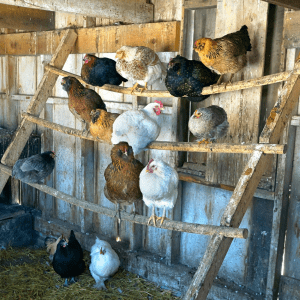
6.1. Designing Comfortable Nesting Boxes
For happy hens and a consistent supply of fresh eggs, designing comfortable nesting boxes is vital.
Your nesting boxes should be spacious enough for a hen to stand and turn around comfortably, typically around 12×12 inches in size. It’s important to place them in a quiet, darker part of the coop to provide the privacy your hens need for laying their eggs.
6.2. Positioning Roosting Bars Correctly
Designing the perfect roosting bars for your chickens is just as important as nesting boxes. This should be sturdy and provide enough space for all your chickens to roost comfortably together, with about 8-10 inches of perch space per chicken.
It’s crucial to position the roosting bars higher than the nesting boxes to prevent roosting in the latter, helping your chickens feel safe from predators while they sleep.
This set-up not only promotes healthy sleep patterns but also prevents behavioral issues and reduces stress among your flock.
By providing comfortable nesting boxes and correctly positioning roosting bars, you’ll create a cozy environment that promotes well-being for your chickens.
7. Access to Food and Water in Backyard Chicken Coops
7.1. Selecting the Right Feeders and Waterers
For your chickens to thrive, it’s crucial to choose the right feeders and waterers. Select a feeder that can hold a sufficient amount of feed for your flock, preventing frequent refills. Opt for a design that keeps the feed dry and clean, such as a hanging feeder or treadle feeder. Similarly, choose waterers that are easy to clean, refill, and cannot be easily tipped over by curious beaks. Look for options with easy-to-access valves or nipples to ensure a steady supply of fresh water.
7.2. Placement for Easy Access and Cleanliness
Any convenience in the coop is greatly appreciated by both you and your chickens. When placing your feeders and waterers, ensure they are elevated off the ground to prevent contamination from droppings. Additionally, position them in a well-lit area for easy access during the day. Consider hanging feeders and waterers in specific spots to encourage chickens to spread out and reduce competition during feeding time.
Food and water are imperative for the health and well-being of your feathered friends. By selecting the appropriate feeders and waterers and strategically placing them for easy access and cleanliness, you are ensuring that your chickens have constant access to fresh food and water, promoting their overall happiness and productivity.
8. Cleaning and Maintenance

Despite our best efforts, chicken coops can get messy pretty quickly. Regular cleaning and maintenance are imperative to ensure a healthy environment for your flock. By staying on top of these tasks, you can prevent diseases, improve egg production, and keep your chickens happy and thriving.
8.1. Design Features for Easy Cleaning
To make your cleaning routine a breeze, consider incorporating design features that promote easy maintenance.
Sliding trays under roosting bars can make droppings removal effortless, while removable nest boxes allow for quick cleaning and inspection of eggs. Additionally, smooth surfaces and materials that are easy to wipe down can save you time and effort.
8.2. Regular Maintenance Checklist
To keep your coop in top shape, stick to a regular maintenance schedule.
Cleaning nesting boxes weekly, scrubbing waterers monthly, and replacing bedding as needed are all crucial tasks. In addition, checking for signs of pests or mold regularly can help nip potential issues in the bud.
Regular maintenance not only keeps your coop looking tidy but also ensures the health and well-being of your chickens. By staying proactive and addressing any issues promptly, you can create a safe and comfortable environment that supports a happy and productive flock.
9. FAQ’s on Backyard Chicken Coops
Q: Why is proper ventilation important in backyard chicken coops?
A: Proper ventilation is important in a chicken coop to prevent dampness and ammonia build-up, which can lead to respiratory problems in chickens. Good airflow ensures a healthy environment for your flock.
Q: How much space do my chickens need in the coop?
A: It is recommended to provide at least 3-4 square feet per chicken inside the coop and about 10 square feet per chicken in the outdoor run. More space allows chickens to roam, peck, and play comfortably.
Q: How can I protect my chickens from predators?
A: To protect your chickens from predators, use hardware cloth instead of chicken wire, secure all entry points, and consider using an automatic coop door that closes at dusk and opens at dawn. This helps keep your feathered friends safe from potential threats.
Q: What should I consider when setting up nesting boxes for my hens?
A: When setting up nesting boxes for your hens, make sure each box is spacious enough for a hen to stand and turn around comfortably, around 12×12 inches. Place the nesting boxes in a quiet, darker part of the coop to provide privacy for your hens when they lay their eggs.
Q: How often should I clean my chicken coop?
A: Clean the coop thoroughly every few weeks and do spot cleaning weekly to maintain hygiene and prevent diseases. Keeping the coop clean is vital for the health and well-being of your flock.
Chicken Tractor for Your Flock
Squirrel-Proofing Your Chicken Coop












